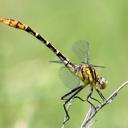United States and Canada
This species is lighter in color than Black-shouldered Spinyleg (D. spinosus), and is similar to Southeastern Spinyleg (D. armatus), with distinct dark antehumeral and humeral stripes. The face is yellow and never marked with a black cross-stripe. The vertex is dark brown and the females lack spines. The thorax is yellowish-green. The middorsal thoracic stripe parallels the anterior collar so that it nearly contacts the antehumeral stripe at its lower end. The dark antehumeral and humeral stripes are separated by a pale yellowish-green stripe of equal or greater width. The midlateral stripe is more developed than in Black-shouldered Spinyleg (D. spinosus), but does not reach far beyond the spiracle. The third lateral stripe is hardly wider than the suture itself. The wings each have a yellow costa. The abdomen is brownish-green with an interrupted dark dorsolateral stripe on segments 3-6. Segments 7-9 are orange brown and expanded greatly in males, more so than in other spinyleg species.
Size: Total length: 60-61 mm; abdomen: 43-46 mm; hindwing: 35-38 mm.
Similar Species (south-central US): Southeastern Spinyleg (D. armatus) is much less common, larger and generally has darker markings. It also lacks the pale rings on the abdomen seen in Flag-tailed Spinyleg. Other clubtail species can be distinguished by their shorter legs which lack prominent spines.
Habitat: Small, clear sandy or mud bottomed streams with a regular current.
Natural History: Mauffray (1997) reported that the six Louisiana parish records, cited in Bick (1957), were based on larval identifications and may be invalid. Those parishes (Bossier, East Feliciana, Saint Tammany, Tangipahoa, Washington and Webster) have therefore not been included in the distribution of this species. Flag-tailed Spinyleg can be common in the region. They may often be seen perching along the shore or occasionally on vegetation. They regularly patrol over the water where they may hover for extended periods similar to species of ringtails (Erpetogomphus).
Distribution: Southeastern U.S. and Canada, southwestward into Mexico.
Source: Abbott, J.C. 2006-2010. OdonataCentral: An online resource for the distribution and identification of Odonata. Available at OdonataCentral.
Edited by Drew Weber (9/24/2015).
